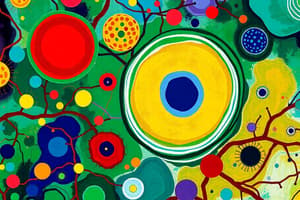Podcast
Questions and Answers
Which branch of biology focuses on the study of viruses and bacteria?
Which branch of biology focuses on the study of viruses and bacteria?
- Zoology
- Microbiology (correct)
- Botany
- Genetics
Which of the following processes describes the ability of organisms to maintain a stable internal environment?
Which of the following processes describes the ability of organisms to maintain a stable internal environment?
- Photosynthesis
- Evolution
- Homeostasis (correct)
- Reproduction
What is the primary source of chemical energy for autotrophic organisms?
What is the primary source of chemical energy for autotrophic organisms?
- Wind energy
- Solar energy (correct)
- Organic compounds
- Inorganic minerals
Which level of biological organization consists of groups of similar cells?
Which level of biological organization consists of groups of similar cells?
Which of the following biological molecules is primarily responsible for carrying genetic information?
Which of the following biological molecules is primarily responsible for carrying genetic information?
Flashcards are hidden until you start studying
Study Notes
Definition
- Biology is the study of living organisms, their structure, function, growth, evolution, distribution, and taxonomy.
Branches of Biology
- Zoology: Study of animals.
- Botany: Study of plants.
- Microbiology: Study of microorganisms.
- Ecology: Study of ecosystems and interactions between organisms and their environment.
- Genetics: Study of heredity and variation in organisms.
- Molecular Biology: Study of biological processes at the molecular level.
- Cell Biology: Study of cell structure and function.
Key Concepts
- Cell Theory: All living organisms are composed of cells; the cell is the basic unit of life.
- Evolution: Change in the heritable characteristics of biological populations over successive generations.
- Homeostasis: The ability of an organism to maintain a stable internal environment despite external changes.
- Energy Flow: Energy transformation in ecosystems; producers (plants) convert solar energy to chemical energy, which is then transferred through the food web.
Biological Molecules
- Carbohydrates: Provide energy and structural support (e.g., sugars, starch).
- Proteins: Made of amino acids; function as enzymes, structural components, and signaling molecules.
- Lipids: Fats and oils; important for energy storage and cell membranes.
- Nucleic Acids: DNA and RNA; carry genetic information.
Levels of Biological Organization
- Molecular: Atoms and molecules (e.g., proteins, nucleic acids).
- Cellular: Cells (e.g., muscle cells, nerve cells).
- Tissue: Groups of similar cells (e.g., muscle tissue).
- Organ: Structures made of tissues (e.g., heart, liver).
- Organ System: Group of organs working together (e.g., circulatory system).
- Organism: Individual living entity.
- Population: Group of organisms of the same species in a specific area.
- Community: Different populations interacting in a defined area.
- Ecosystem: Community plus the physical environment.
- Biosphere: Global ecological system integrating all living beings and their relationships.
Types of Nutrition
- Autotrophic: Organisms that produce their own food (e.g., plants via photosynthesis).
- Heterotrophic: Organisms that consume other organisms for food (e.g., animals).
Reproduction
- Asexual Reproduction: Involves a single organism; offspring are genetically identical (e.g., budding, binary fission).
- Sexual Reproduction: Involves two organisms; offspring have genetic variation (e.g., fertilization).
Important Processes
- Photosynthesis: Process by which plants convert sunlight into chemical energy.
- Cellular Respiration: Process by which cells convert glucose and oxygen into energy, carbon dioxide, and water.
Evolutionary Theory
- Natural Selection: Mechanism by which individuals with favorable traits are more likely to reproduce.
- Speciation: The formation of new and distinct species in the course of evolution.
Tools of Biology
- Microscope: Instrument used to observe small organisms and cells.
- DNA Sequencing: Techniques used to determine the nucleotide order of DNA.
Applications of Biology
- Medical Biology: Study of organisms to advance human health (e.g., drug development).
- Conservation Biology: Protecting biodiversity and ecosystems.
- Biotechnology: Manipulation of living organisms for practical applications (e.g., genetic engineering).
Definition of Biology
- Biology encompasses the study of all living organisms, their structure, function, growth, evolution, distribution, and classification (taxonomy).
Branches of Biology
- Zoology: Focuses on the intricate life forms and behaviors of animals.
- Botany: Investigates the diverse characteristics and life processes of plants.
- Microbiology: Examines microorganisms, highlighting their significance in health and environment.
- Ecology: Explores ecosystems, emphasizing interactions between organisms and their habitats.
- Genetics: Studies heredity and genetic variations across species.
- Molecular Biology: Analyzes biological functions and structures at the molecular level.
- Cell Biology: Investigates the structure, function, and life processes of cells.
Key Concepts
- Cell Theory: Establishes that all living organisms consist of cells, making them the fundamental unit of life.
- Evolution: Describes the gradual changes in genetic traits of populations across generations.
- Homeostasis: Refers to the ability of organisms to maintain stable internal conditions in response to external changes.
- Energy Flow: Outlines the transformation of energy in ecosystems, where producers convert solar energy into chemical energy for consumers.
Biological Molecules
- Carbohydrates: Serve as a primary energy source and provide structural support (e.g., sugars and starches).
- Proteins: Composed of amino acids, play critical roles as enzymes, structural components, and signaling agents.
- Lipids: Include fats and oils, essential for energy storage and cellular membrane composition.
- Nucleic Acids: DNA and RNA are responsible for storing and transmitting genetic information.
Levels of Biological Organization
- Molecular: Atoms and molecules form the foundational biological compounds.
- Cellular: Specialized units such as muscle and nerve cells constitute functional units of life.
- Tissue: Groups of similar cells work together for specific functions (e.g., muscle tissue).
- Organ: Composed of tissues, performing particular functions (e.g., heart, liver).
- Organ System: Groups of organs that collaborate (e.g., circulatory system).
- Organism: An independent living entity.
- Population: A gathering of organisms of the same species in a particular area.
- Community: Various populations interacting within a defined ecosystem.
- Ecosystem: The integration of biological communities with their physical environments.
- Biosphere: The global ecological system, encompassing all living organisms and their interrelations.
Types of Nutrition
- Autotrophic: Organisms like plants produce their own food, mainly through photosynthesis.
- Heterotrophic: Organisms, such as animals, must consume other living entities for nourishment.
Reproduction
- Asexual Reproduction: Involves one parent; offspring genetically identical through processes like budding or binary fission.
- Sexual Reproduction: Involves two parents; offspring exhibit genetic variation through fertilization.
Important Processes
- Photosynthesis: Process by which plants convert sunlight into chemical energy stored as glucose.
- Cellular Respiration: Process in which cells convert glucose and oxygen into energy, releasing carbon dioxide and water.
Evolutionary Theory
- Natural Selection: The process whereby individuals with advantageous traits are more likely to reproduce and pass on their traits.
- Speciation: The evolution of new and distinct species, resulting from genetic divergence.
Tools of Biology
- Microscope: Essential instrument for magnifying and observing microscopic organisms and cells.
- DNA Sequencing: Techniques that identify the nucleotide sequence of DNA, crucial for genetic research.
Applications of Biology
- Medical Biology: Enhances human health through the study of organisms, aiding in drug development and disease understanding.
- Conservation Biology: Focuses on preserving biodiversity and protecting ecosystems from degradation.
- Biotechnology: Involves manipulating living organisms for practical benefits, including advancements in genetic engineering.
Studying That Suits You
Use AI to generate personalized quizzes and flashcards to suit your learning preferences.




